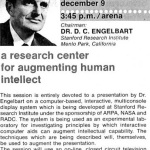Recently, Computer Weekly highlighted five heroes of the web. Below is a compilation of these heroes and significant moments, considered the most influential people and breakthroughs in the development of the Internet as we know it today.
- Tim Berners-Lee
Source: Georgia Oetker
In the early 1990’s document access systems were closed, proprietary and single-user in nature. Tim Berners-Lee, a developer at CERN and inventor of the World Wide Web, sought a better, fundamentally open way for research communities to find and share information, Berners-Lee developed the HTTP and HTML protocols as well as a browser he offered freely for users to access the early Internet. On 6 August, 1991, he invited anyone to download his invention. In a newsgroup posting he wrote:
“The WWW model gets over the frustrating incompatibilities of data format between suppliers and reader by allowing negotiation of format between a smart browser and a smart server. Try it.”
Today, the protocols developed by Berners-Lee, and many other internet protocols developed by the World Wide Web Consortium under Berners-Lee, serve as the foundation for the Web as we know it. Without the open capabilities Berners-Lee created, it is unlikely the web would have evolved beyond anything other than an interesting, but vaguely understood idea.
- Doug Engelbart and Company
Source: Computer Weekly
Doug Engelbart and a group from Augmented Human Intellect (AHI) Research Center at Stanford Research Institute gave a demonstration on how IT would change the way people work. The 90 minute demo to 1,000 computer professional was the first public showing of a mouse, hypertext linking. This significantly shaped the concept of personal computing.
3. Vint Cerf and Robert Kahn
Source: Computer Weekly
Vint Cerf, VP and Chief Internet Evangelist at Google, and Robert Khan, Chairman, CEO and President of the Corporation for National Research Initiatives (CNRI) are both considered “Fathers of the Internet”. In the early 1980’s the two designed the standard networking protocol, TCP/IP, which made it possible for people to download the source code for web browser software developed by Tim Berners-Lee at CERN. Today TCP/IP continues to enable modern networking and communication.
- NeXT Cube: The Unix workstation that ran the first WWW
Source: Computer Weekly
Tim Berners-Lee initially traveled with this machine to demonstrate what the web looked like. It was able to run across CERN’s internal networks. CERN later connected the server to its TCP/IP network, which allowed the web to be accessed everywhere using the TCP/IP protocol. The first web page was launched at CERN on 20 December 1990.





